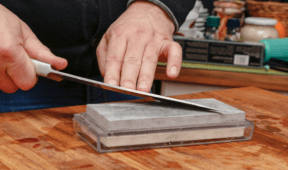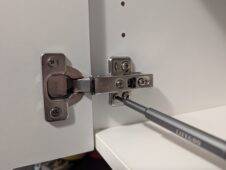How to: Make a DIY George Nelson-Inspired Outdoor Slat Bench

When my neighbor, Gina, moved in next door, a standalone porch swing appeared on our shared patio. The thing was at least thirty years old, and had been outside for just as long, and showed the wear of snowy winters, blazing hot summers, and all the rainy days in between. Not that it was likely much to look at when it was new.
It was, in every way, an eyesore.
But, my goodness, if that thing wasn’t useful. I’m sure I sat on it a good fifty times more often than she did. I took to enjoying my breakfast on it, and built a little morning routine around sitting outside, reading the week’s New Yorker before I started my day. I used it to prepare for my bike rides: changing shoes, making adjustments, etc. And my friends and I would eat dinner out there, and watch thunderstorms. Boy, it was ugly, but it made me appreciate my patio, and got me out there frequently.
Then, Gina did the unthinkable: she got married, had a baby, and moved away. And, with her, away went the porch swing. And though I love my current neighbor (Hi Jillian!), she brought no shared furniture to the arrangement.
So, I figured it was time to make some outdoor seating of my own. For inspiration, I turned to the most iconic of mid-century bench designs, the Platform Bench by George Nelson (1946). It was created from easy-to-find 1×6″ cedar decking, making it quite inexpensive to build, and safe for outdoor use.
Wanna make one, too? Okay, here we go…

Note: Yes, I have a collection of power tools, and used them on this project. But they are not necessary to complete a build like this. The great part about the slat design is that you can buy the wood already dimensioned, and cut it and the joints with a handsaw. This project could be completed with minimal tools you can find at your local hardware store: an inexpensive pull-saw, like a Dozuki or dovetail saw, a few clamps, a chisel, a drill, and some sandpaper.

Designing and materials. I researched the Nelson bench online, and while I found lots of knockoff designs, I couldn’t find anyone who’d done an actual tutorial on how to make one yourself. So, I guess the task is up to me.

The most helpful resource were the official pages at Herman Miller and DWR. Both include measured drawings, as well as detailed photos from multiple angles. In researching those sites, I decided to model mine on the medium size, 60″. (It comes in 4′, 5′, and 6′ lengths). The measured drawings indicate a total of twelve slats and a width of 18.5 inches. So, by my calculations: 18.5″ divided by 23 [12 slats + 11 finger joints] gets you a width of 13/16″ for each slat. That’s a complex number, and a lot of math to account for, so I decided to make my slats 7/8″. It’s an easier number to deal with, plus my local True Value hardware store actual sells 7/8″ x 1 3/4″ cedar stock, so those of you without fancy woodworking tools can make one too! Plus, since it will be outside, I like the bigger scale.
A note about cedar: Nelson’s design is made of hard maple, and for good reason: it’s very strong, and has a straight grain pattern that allows the wood to be milled flat, essential for this geometric design. Cedar, while great for the outdoors, is a soft wood, and is not nearly as straight. When selecting wood, take your time to find the flattest, most twist-free lumber in the stack. It’ll save you lots of headaches later.
I chose to make my bench from 1×6″ cedar decking, which is actually at 1 1/8″ thick by 5 1/2″ wide and 8″ long. Choosing the rougher wood and “milling” it at home saved me tons of money. I bought six 8′ long decking planks, costing only $70. Compared to the near $800 price tag of an actual Nelson bench, that’s a value indeed.

Milling the slats and rails. Once I selected the straightest 1×6″s I could find and brought them home, I cut them to an exact 60″ length. When working with dimensional lumber like this, its important to first trim one edge flush, as they’ll often have craggy edges, then cut them to length. This gave me six 5′ lengths, and the leftover 36″ (or so), to create the rails. I planed them down, 1/32″ at a time, using my powered planer (my newest woodworking tool that I totally love) to an exact thickness of 7/8″.

Since the bench is constructed with box joints (also called finger joints), the height of each slat needs to be exactly twice that of its thickness. For this project, that’s 1 3/4″. (See why I went with 7/8″ instead of 13/16″?) So, I cut two 1 3/4″ slats from each 1 x 6″ on my tablesaw, giving me twelve slats, 60″ long, 1 3/4″ tall, and 7/8″ thick.

Then, knowing I’d need a double thickness rail for the center of the bench, I glued up a block from the scraps, and when dry, cut this and the two side rails to 1 3/4″ tall, and 20 1/4″ long (7/8″ x 23).

All sliced up and ready to go!
Cutting the joints. To create those signature box joints, I opted to use my stacked dado head cutter. This is a series of blades, chippers, and shims that can be stacked to cut dadoes (thick kerfs) in wood for joinery. When using the shims, be sure to make a test cut in a scrap to make sure your dado is exactly 7/8″ wide, or else the box joint assembly won’t work. Then, set the height of the cutter to 7/8″ to make a perfect square.

Because my dado’s maximum thickness is 7/8″, I couldn’t set the fence (even a sacrificial one) right next to the blade and get the cut I want. So, I had to adjust my plans a bit, cut the box joint 1″ from the end, and then trim it off later. So, technically, my bench is 58″ long. No big deal.
I cut mine six at a time, lightly clamping them together, and using the miter guage to keep everything flush. You can use a crosscut sled, but I didn’t want to cut the 7/8″ kerf into mine, for only one project. If I were making these en masse, it’d definitely be the way to go.
If you don’t have dado blade, you can just make repeated passes with the blade set to 7/8″ high, until you’ve cut a 7/8″ thick dado. If you don’t have a dado blade or a table saw, you can use your dovetail saw to cut these. It’s what the tool was designed for! It’ll take longer, but you get super accurate cuts with these saws, so put on a movie, and get going.

Note: when cutting soft woods like cedar with a dado blade, you’re going to get a lot of tearout on the “exit wound.” So, place a scrap behind all your cuts to minimize the carnage.

Then, cut the double width dado, 1 3/4″, in the center. As you can see in the photo, it’s tough to keep such long irregular wood flush to the table, so be sure to exert downward force so your height is spot on. (I admit it, this was a posed shot. It’s tough to manuever 5 feet long pieces of wood over a spinning blade of death with one hand while trying to take a photo…)

Cutting the rails. Now, the fun part: cutting the female dadoes to equally space the slats in the box joints. They make commercial jigs for smaller finger joints, but I couldn’t find one that was as large as 7/8″, so i made a custom one. You can see it at the back of the photo there: it’s just a piece of scrap the sits against the miter guage, and has a spacer of 7/8″ x 7/8″ (the size of our dado) sitting at 7/8″ from the blade kerf. I made a tutorial for a smaller scale jig a few years ago – the principle is the same.
You can also cut these with your handsaw!

Assembling and gluing up. The best part about using the box joints is that there are NO mechanical fasteners (nails, screws) holding this thing together, just the glued joints. This makes the construction incredibly strong, and allows it to last longer, as the weather will eventually warp the wood, and possibly tear, twist, and pull out the screws.
So, put everything together for a dry fit. Amazing, right? When your working with cedar, it likely won’t just lock together, as the wood is just too squirrly. But, be sure to note any major errors that glue and clamps won’t fix, and fix ’em.

When you’re ready to glue, spread waterproof wood glue glue (I used Titebond III) on the inside of all the joints, and then clamp with as many as you have. You mostly want vertical pressure, but a horizontal clamp along the rail will also keep everything square.
Also, cedar is pretty soft, and you want to use a lot of pressure to secure all those joints, so be sure to use some scrap wood cauls to absorb the contact points and avoid denting the wood.
Let everything cure for twenty-four hours, then….

Get sanding! If you don’t have an electric sander, get one. I guess you could rent one, but that’d probably cost as much as buying a new one. I used my random orbit, starting with a 60 grit to smooth out the joints, then working my way up through 100 & 150 to a smooth 220.

The legs. Of course, a bench isn’t a bench unless there’s something to get it off the ground. I did consider trying to create Nelson’s harp-shaped leg design, but instead opted to purchase some pre-fabricated legs from HairpinLegs.com. Their shop is in my neighborhood! I went with four of the “original legs” in the 14″ height.

The legs are raw steel, so they need to be completely sealed to be outdoor-able. I sprayed them with two coats of metal primer, waiting 30 minutes in between, just to be sure I didn’t leave any steel exposed. Then I sprayed them with two coats of Krylon Dual, which is a primer and paint in one, in a satin black. Maybe that’s overkill, but if I’ve done this much work, there’s no reason to start skimping now. (There’s an abandoned clothesline hanger thingin my neighborhood that make spraying projects like this a breeze.)

Staining and assembling. Though raw cedar can go outside, it will weather to a silvery-gray after a couple of years. I wanted mine to still be…well, cedar-colored, so I finished it with exterior deck sealant.
This was the only part of the project I’m a little disappointed in. Obviously, it’s a complex staining adventure, since you have all those inside spots to get, but deck sealant does not behave the same as regular old wood stain. It’s a lot thicker, and goes on differently. If I had to do this again, I‘d make friends with someone with a power sprayer, or get one myself. If you do stain by hand, work lightly. Don’t worry about evenness of tone, just spread on a thin coat, and remove any drips as quickly as possible
Thankfully, after a few weeks, the stain has soaked into the wood, and the finish is quite beautiful. So! Don’t obsess with looks during the finishing process; eventually, it’ll even out, and the excess sealer isn’t worth it. Plus, you’ll always be able to add more if you want, since there’s no clear coat. I plan to do so every year or two, depending on how it weathers.

So, there you go: a mid-century inspired outdoor bench, made from stuff I found at my local True Value hardware store. I’m sitting on it as I type this very post, and…it’s pretty awesome.
Admittedly, it was a bit of work. I imagine I spent between 9-10 hours on this thing, but a lot of that was the math and figuring out how to put it together. Of course, I’ve done that work now, and it’d take you way less time. Plus, I planed and cut all my own lumber on this. Beginning with cedar 1x2s would save you tons of time. I spent around $85 on wood, glue, and sandpaper, plus the cost of the legs. Hopefully, it’ll last for years of breakfasts. Well worth the effort!










